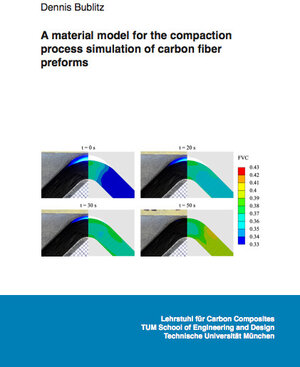
×
![Buchcover ISBN 9783843953726]()
A material model for the compaction process simulation of carbon fiber preforms
von Dennis BublitzIn addition to the processing of pre-impregnated semi-finished products, the so-called prepregs, resin injection processes are one of the most widely used methods for manufacturing composite parts. Although these processes offer some benefits, they still have limitations due to process-related defects, such as pure resin areas in tight radii, dry spots and large process-induced deformations. These defects are often caused by fiber volume content gradients resulting from a non-uniform compaction during mold closing.
In this thesis, a compaction process simulation for dry carbon fiber preforms with an orthotropic nonlinear material model was developed that allows to predict the defects mentioned above. The materials used were experimentally characterized and a new test method for out-of-plane shear stiffness was designed. Based on the obtained data, a compaction model for predicting the time-dependent behavior in thickness direction was developed and validated. Subsequently, the compaction model was extended to include the deformation modes in the remaining directions such as out-of-plane shear. The calibrated model shows an excellent agreement with the experimental results from compaction tests with tight tool radii. The validated model was further used for a virtual study of preform and tool properties, revealing that preforms with high thickness and high fiber volume content are particularly prone to pure resin regions in the radius.
With the developed coupling of the results from the compaction simulation with the filling simulation, it was shown that the consideration of the compaction results has a significant influence on the part filling. The developed simulation model can be applied to avoid compaction defects and to improve part quality. The application to more complex geometries and different materials, can improve the developed simulation method.
In this thesis, a compaction process simulation for dry carbon fiber preforms with an orthotropic nonlinear material model was developed that allows to predict the defects mentioned above. The materials used were experimentally characterized and a new test method for out-of-plane shear stiffness was designed. Based on the obtained data, a compaction model for predicting the time-dependent behavior in thickness direction was developed and validated. Subsequently, the compaction model was extended to include the deformation modes in the remaining directions such as out-of-plane shear. The calibrated model shows an excellent agreement with the experimental results from compaction tests with tight tool radii. The validated model was further used for a virtual study of preform and tool properties, revealing that preforms with high thickness and high fiber volume content are particularly prone to pure resin regions in the radius.
With the developed coupling of the results from the compaction simulation with the filling simulation, it was shown that the consideration of the compaction results has a significant influence on the part filling. The developed simulation model can be applied to avoid compaction defects and to improve part quality. The application to more complex geometries and different materials, can improve the developed simulation method.


